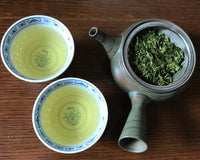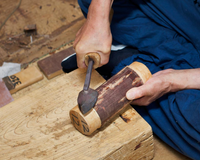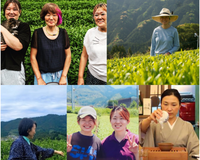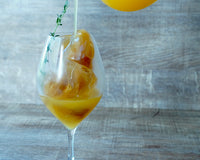First of all, a very warm youkoso (welcome) to you! At Yunomi, we have the largest selection of Japanese teas and this can be a wonderful delight to tea connoisseurs and aficionados who know what they are looking for. However, we also know it can be a bit daunting for those of you who are just taking the first steps to initiating your journey into the Japanese tea world. So, here’s hopefully, a simple guide on how to choose your teas through the Yunomi site (or elsewhere). Especially as we are all navigating Covid-19 times, you may have limited access to your nearest tea shop, etc… so we wanted to make it easier to get started exploring Japanese tea and provide some ‘pep in the step’ to try something new !
1. Start with a Sencha (煎茶)
For your first Japanese tea dance partner, we recommend the most basic, popular, and common type of Japanese tea, which is called a sencha. If you have an opportunity to visit Japan, it is likely that sencha will be served to you multiple times. Sencha is often served in restaurants after meals, with wagashi (Japanese dessert) and socially. If you have or make acquaintances, it is very common for a household to have sencha readily available in their home to serve to guests, especially the homes of older folks.
Last year, I was helping out at a ningyō jōruri (人形浄瑠璃; a form of traditional Japanese puppet theater) festival, held in a mountain village in Tokushima prefecture, Japan. The volunteers and I went around the village homes to get to know the residents of the village. Each time we were welcomed into a new home, we were always greeted with a freshly brewed cup of sencha. So, getting familiar and acquainted with sencha is a good foundational first step to connecting to people!

Gathering and chatting with cups of sencha. Because it was a rainy day, the cup of tea felt especially welcoming. Photo by Olga Zaimentceva.
Talking about the different growth conditions and processing of different types of tea can make things seem complicated. So, for now, just know that sencha is a typical steamed Japanese tea that is grown in full sunlight (If you continue on with the Japanese tea adventure, you are likely to learn more details). Few teas from China, India or other places go through the same steaming process, so one can say that the steaming is part of what defines Japanese tea. Also note that cha is Japanese for “tea” (depicted with the character 茶)that is why many of the Japanese teas have cha at the end.

Dry Sencha Leaves
Searching for sencha on the Yunomi site will give you approximately 200 choices! We know that this may be quite overwhelming (even for someone like me accustomed to Japanese tea). So see if you can simply select a tea package image that you like, or read a few descriptions of the tea farm/family to see if any resonate with you! This is actually what we feel is essential at Yunomi (i.e., connecting “people-to-people”) and fostering a sense of connection with the tea farmers who grow your tea. And of course, selecting those with a price within your budget is a first step. Know that hand-picked teas will be higher quality but also higher in price and that as a newbie, you may not be able to tell the difference. And don’t worry about cultivars for the time being, although this information will likely be presented.
Sencha Recommendations:
- Hachimanjyu Organic Yakushima Standard Sencha (100g/$10.00): A reasonably priced standard sencha that is enjoyed by many as their everyday tea. This tea comes from the famous Yakushima Island, where Princess Mononoke’s kodamas reside. Not too astringent.
- Tarui Elegant Beauty from Tarui-san in Shizuoka (100g/$18.99): One of the first senchas I tried from Yunomi. I wanted to try a spring harvested sencha from Shizuoka prefecture and Tarui-san's wonderful smile helped me make my decision. More flavorful than your typical sencha (in a good sense) and one that will last for many steeps!
 Tarui-san from Tarui Tea Farms
Tarui-san from Tarui Tea Farms
2. Want another option? Add a genmaicha and/or a hojicha
For those of you who are open to exploring a bit more and would like to try more than one type of tea. My recommendation is to add a genmaicha or hojicha along with your sencha.
Genmaicha(玄米茶):
Genmaicha is a traditional type of Japanese tea composed of a combination of sencha (steamed Japanese tea grown in full sunlight) mixed with toasted rice. While the specific ratio depends on the tea farmer, generally, the tea to toasted brown rice ratio is approximately 1:1. Sometimes there are fun surprises when the rice puffs, similar to popcorn! Because of how genmaicha is mixed with rice it contains less caffeine, an advantage for those of you who would like something lighter but still looking to try an authentic Japanese tea.

Genmaicha Brown Rice Green Tea
I personally love the hearty flavor of this tea as well as the roasty rice flavored scent, reminding me of home. It also tends to be a favorite amongst many of my overseas (i.e., non-Japanese) friends. Recently, I was pleasantly surprised when enjoying this type of tea over breakfast at a dance gathering. Two Czech women could tell I was about to drink genmaicha just from the smell of the tea!
On the Yunomi site: Go to Green Tea - Post processed, flavored green tea, and click on genmaicha. This will present you with a selection of genmaichas!
Genmaicha recommendations:
- Yunomi Tea House Blend: Genmaicha Brown Rice Green Tea (100g/$ 6.99 - 9.99): A nice genmaicha to begin with. I recommend selecting the premium spring leaf version but there are options.
- NaturaliTea: Genmaicha Brown Rice Green Tea (200g/$16.00): The genmaicha that is currently in my tea selection. Not only have I been enjoying the aroma and taste of this tea, the rice puffs appear to me like white flowers.
Hojicha (ほうじ茶):
A roasted Japanese tea, which I personally feel deserves more attention outside of Japan. Hojicha is actually a sencha transformed by an additional roasting, which gives the special dark and nourishing taste. Sometimes, hojichas are suggested to people who simply do not like the vegetal nature of steamed Japanese teas. It also contains very little caffeine so it is suitable for everyone, including babies. While senchas produce a golden green yellow color, hojicha has a transparent brown color. I personally like drinking hojichas in the autumn/winter months and they also pair nicely with Western desserts like apple pie, something chestnut-y or chocolaty. And although I will not be touching on matcha today, hojicha can also be a very nice compliment after matcha.
On the Yunomi site: Go to Green Tea - Post processed, flavored green tea, and click on hojicha. This will present you with a selection of hojichas!
Hojicha Recommendations
- Okada Tea Farm's Naturally Grown Hojicha Roasted Green Tea - Meiko (200g/$14.99): Organically produced with the Natural Farming (自然農法; Shizen Nouhou in Japanese) philosophy.
- Obubu’s Hojichas (80g/$9.75): The town Wazuka (near Kyoto/Nara prefectures) has a place in my heart and the people at Obubu are also wonderful! On their hojicha page, a video with English subtitles on how to steep hojicha can be found. You can also choose a normal roast or a darker roast for earthier flavor.
- For those of you who prefer tea bags, here is a lovely option: Spring Hojicha Roasted Green Tea (tea bags) by Zenkouen Tea Garden
 Cup of hoijicha with traditional Japanese snacks, karintō by Zenkouen Tea Garden
Cup of hoijicha with traditional Japanese snacks, karintō by Zenkouen Tea Garden
3. Feeling adventurous? Include a Gyokuro (Japanese: 玉露) in your mix
One last suggestion from me before we wrap up. That is, if you are open to spending a bit more money on high quality Japanese tea, I would suggest adding a gyokuro in your Japanese tea dance. We mentioned earlier that a sencha is basically a steamed Japanese green tea grown in full sunlight. While gyokuro is made with the same steaming, then rolling process, it is different in that it is shaded (on purpose) from the sun for approximately 20 days. The exact length varies by farmer and region.
 Azuma Tea Gardens (Wazuka, Kyoto) shading their tea bushes
Azuma Tea Gardens (Wazuka, Kyoto) shading their tea bushes
If sencha is considered the classic steamed green tea, gyokuro would be the pinnacle of umami and aroma and is often referred to as premium shaded Japanese tea. But please note that “premium” does not make it superior to a sencha. In brief, gyokuro is unique because of how shading affects photosynthesis and plant physiology resulting in more umami.
The reason I hesitate to recommend it for everyone is because gyokuro can be quite expensive. Its higher costs are due in part to the additional shading step (which is depicted in the photo above with the tea farmer covering up the tea bushes with black synthetic fiber). A gyokuro will let you experience an intense gustatory sensation of “umami”, which is helpful to identify as you continue dancing in the world of Japanese tea. Oh, and it's also simply yummy!
Perhaps, I would like to emphasize that if you do plunge into a gyokuro, please follow steeping instructions. And while it is expensive, please know that one is able to enjoy multiple steeps (at least 3-4) of tea. And some people even eat the tea leaves!
On the Yunomi site: Go to Green Tea - to the left most column, you will find gyokuro (heavily shaded).
Gyokuro Recommendations:
- Nishide Uji Standard Gyokuro: A very reasonable price for gyokuro (100g/$24.99). A great gyokuro for starters from Uji, a famous tea producing region in Japan.
- Premium Gyokuro Green Tea from Kurihara Farms (100g/$33.00): A gyokuro from Yame in Fukuoka prefecture, another famous tea producing region. The Yame region is especially well known for their high quality gyokuro teas.
We hope this guide may help you navigate your first steps into Japanese tea. Please feel free to ask us additional questions (e-mail: support@yunomi.life), we are always available and happy to help. Another virtual community space in which you may ask questions and/or learn about Japanese tea is the Japanese tea connoisseurs Facebook page - open to all.
We wish you happy tea explorations!
Feature Image: A cup of tea at Ippodo, Kyoto, Japan, photo by Moé Kishida.







2 comments
Moé
Hi Lawrence,
Thank you for your questions. Generally, new crop tea refers to “shincha”, or tea harvested from the first flush season (which can vary from late March ~ June, depending on the region, etc.). With respect to the cut leaf green tea you refer to, I wonder if the tea you experienced in Japan was a kukicha or mecha (bud tea)… Do any of these Japanese teas sound familiar to you?
Kukicha: https://yunomi.life/collections/kukicha
Mecha: https://yunomi.life/collections/green-tea/mecha
The name of the green tea with matcha powder on the leaves is actually one from Yunomi called, Spring Sencha with Matcha Blend.
We hope this was helpful!
Lawrence Ivy
When I was in Japan I experienced tea that was a new crop Cut leaf green tea- I do not know the name but it as fantastic and I bought a pound of it-
Do you sell cut leaf green tea? What are the names-
I’m my first order , previous to this one I purchased a green tea with matcha powder on the leaves- what was the name it that tea- I can not locate my order Paper.
Thank you
Lawrence